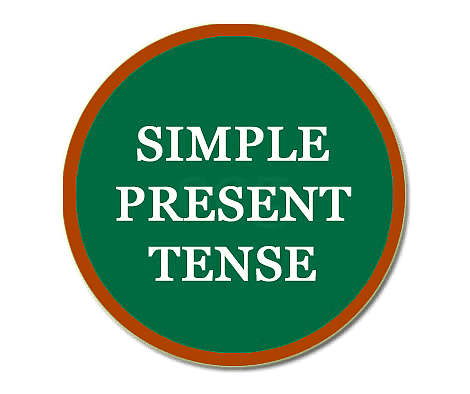Simple Present Tense: Tenses | English Language & Comprehension for SSC CGL PDF Download
What is Simple Present Tense
According to the Cambridge Dictionary, the simple present tense form of the verb in a sentence is defined as “the tense that is used to refer to events, actions, and conditions that are happening all the time, or exist now.” The Cambridge Dictionary gives a much more elaborate definition of the simple present tense. According to them, “the present tenses of a verb are the ones that are used to talk about things that happen regularly or situations that exist at this time. The simple present tense uses the base form or the ‘s’ form of a verb, as in ‘I play tennis twice a week’ and ‘She works in a bank’.”

Basics of Simple Present Tenses
- The simple present is a verb tense with two main uses. We use the simple present tense when an action is happening right now, or when it happens regularly (or unceasingly, which is why it’s sometimes called present indefinite).
- Depending on the person, the simple present tense is formed by using the root form or by adding '‑s' or '‑es' to the end.
Examples: (i) I feel great!
(ii) Pauline loves pie.
(iii) I’m sorry to hear that you’re sick.
(iv) The other is to talk about habitual actions or occurrences.
(v) Pauline practices the piano every day.
(vi) Ms. Jackson travels during the summer.
(vii) Hamsters run all night. - Typically, when we want to describe a temporary action that is currently in progress, we use the present continuous.
Example: Pauline can’t come to the phone right now because she is brushing her teeth.
Structure of the Simple Present Tense

Formation of Simple Present Tense
1. In the simple present, most regular verbs use the root form, except in the third-person singular (which ends in -s).
- First-person singular: I write
- Second-person singular: You write
- Third-person singular: He/she/it writes (note the ‑s)
- First-person plural: We write
- Second-person plural: You write
- Third-person plural: They write
2. For a few verbs, the third-person singular ends with -es instead of -s. Typically, these are verbs whose root form ends in o, ch, sh, th, ss, gh, or z.
- First-person singular: I go
- Second-person singular: You go
- Third-person singular: He/she/it goes (note the ‑es)
- First-person plural: We go
- Second-person plural: You go
- Third-person plural: They go
3. For most regular verbs, you put the negation of the verb before the verb, e.g., “She won’t go” or “I don’t smell anything.” The verb to be is irregular:
- First-person singular: I am
- Second-person singular: You are
- Third-person singular: He/she/it is
- First-person plural: We are
- Second-person plural: You are
- Third-person plural: They are
How to Make the Simple Present Negative?
- The formula for making a simple present verb negative is do/does + not + [root form of verb]. You can also use the contraction don’t or doesn’t instead of do not or does not.
Examples:
(i) Pauline does not want to share the pie.
(ii) She doesn’t think there is enough to go around.
(iii) Her friends do not agree.
(iv) I don’t want pie anyway. - To make the verb to be negative, the formula is [to be] + not.
Examples:
(i) I am not a pie lover, but Pauline sure is.
(ii) You aren’t ready for such delicious pie.
How to Ask a Question?
- The formula for asking a question in the simple present is do/does + [subject] + [root form of verb].
Example: Do you know how to bake a pie? How much does Pauline love pie?
- Table: The Verb to Be in the Simple Present

Common Verbs in the Simple Present
1. Affirmative Form
- Subject + Verb + Complement
I speak English.
2. Negative Form
- Subject + Don't / Doesn't + Verb + Complement
I don't speak English.
Rules and Points to Remember When Using the Simple Present Tense
- In order to use the simple present tense accurately and effectively, there are some rules and points you have to keep in mind. This is because of the fact that the sentence or the context would not make sense if the verb does not agree with the subject in the sentence.
- The first thing that you should understand about the simple present tense is that the verb mostly appears in the base form.
- This changes when a third-person pronoun or subject is used in a sentence. In this case, the verb used should be made plural.
Uses of Simple Present Tense
1. To show a habit- We drink coffee every morning.
2. To express a general truth
- Water boils at 100 degrees.
3. To express an action with a future time expression
- I leave tomorrow.
Example Sentences
- We buy a newspaper every Sunday.
- He doesn't visit his father.
- Does she lie to her mother?
- My sister works at the theater.
- The boss gives us a lot of work to do.
- Marry and Lucas don't play fairly.
- Do you like to read comic books?
- They spend a lot of money.
|
133 videos|234 docs|152 tests
|
FAQs on Simple Present Tense: Tenses - English Language & Comprehension for SSC CGL
| 1. Why are tenses important for MBA exams? |  |
| 2. What is the simple present tense? |  |
| 3. How do you make the simple present negative? |  |
| 4. How do you ask a question in the simple present tense? |  |
| 5. What are some common verbs used in the simple present tense? |  |






















